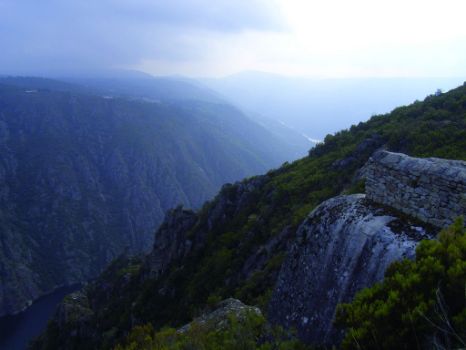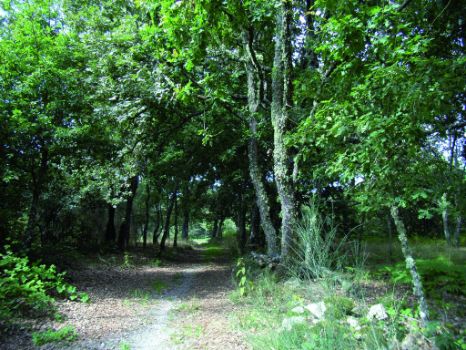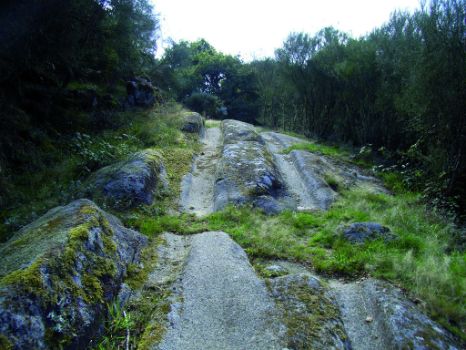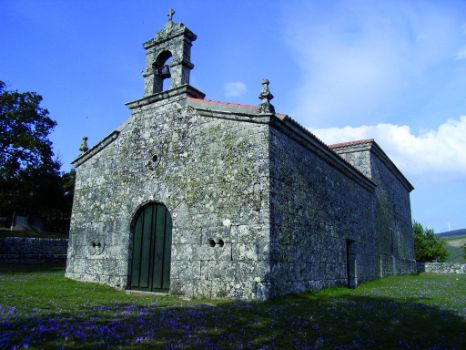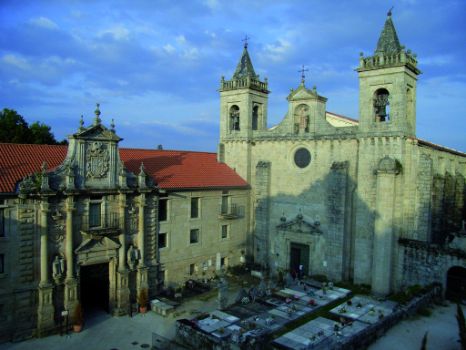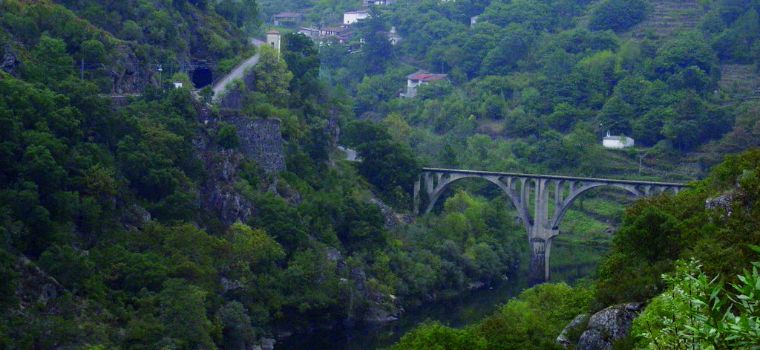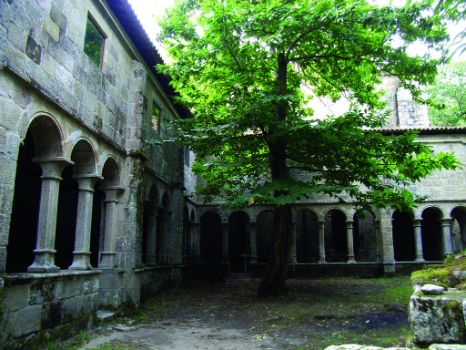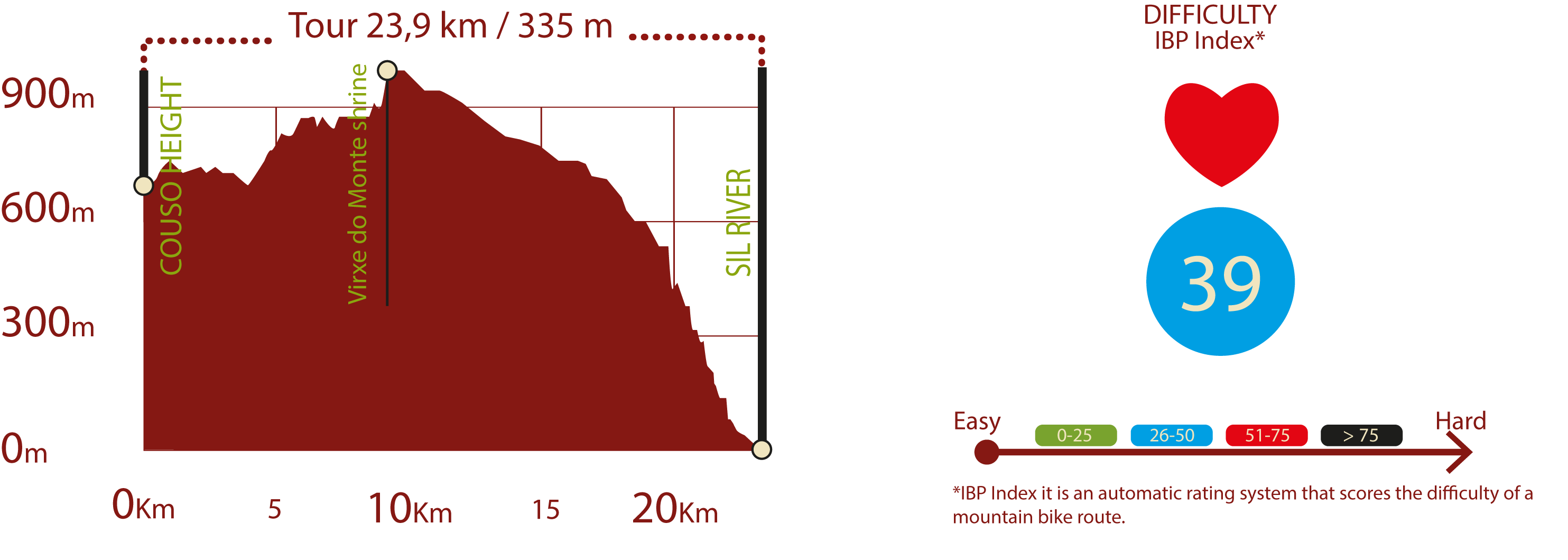Net of Natural
Trails

Ribeira Sacra Nature Trail. Santo Estevo Monastery route
Description
Main Route: Monastery of Santo Estevo and Shrine of Virxen do Monte Route (24 km):
The first half of this route runs in Esgos municipality, and the second half in Nogueira de Ramuín. The route begins at Alto de Couso, and heads north to the town of Meiroás along a small road through pines, oaks, birches, broom and gorse. At the first crossroads, the route turns left to a second intersection, where the Nature Trail continues to the right towards a third crossing where it proceeds straight ahead. The third branch of this Nature Trail, the so-called Meiroás-Melón Baixo Route, starts here to the right. The route passes an intersection and continues to the right for about 300 m, along a narrow gravel path through meadows. The path traverses through the town of Melon Baixo, and heads down from the square to a gravel path via a small flight of stairs.

Taking a right turn at the crossroads, the route heads down the road to Melón Alto. At the entrance to this small town, the route turns right again, behind the bus stop, and continues up the signposted path to a fountain with a watering trough. From here, it leaves the town along a gravel track. It then turns left onto a concrete track that further ahead becomes a narrow bridle path. It reaches another intersection and continues to the right through an oak forest until it reaches a wide gravel road. The route continues to the left, along another branch of the Nature Trail known as "Ruta de los Arcos".
After reaching a stretch that runs over a paved road, the route turns onto a parallel gravel path that heads up a steep slope to the meadow where the shrine of Virxen do Monte can be found. This place has an area with a fountain and several tables to enjoy a well-deserved rest.

The route skirts around the shrine, and turns left onto a gravel road that heads down to the road along which it continues in parallel until it reaches an intersection. Following the gravel track to the left, the route arrives at Nogueira de Ramuín. The track passes in front of a wind farm and seven new intersections to finally reach the town of Casares.
Past the town, the route continues along the road until the first offshoot road to the right. It then heads to the nearby village of Pombar along a gravel track, through gorse and oak trees. It traverses through the streets to reach OU-508. The route continues to climb down, turning on to the first side-track to the left, and heads on to the next crossroads, where it turns right. The road to the left climbs up to the ancient fortress of Penedos do Castro, with magnificent views of the Sil Valley and the Monastery of Santo Estevo.
The trail continues to descend through oaks and chestnuts along a gravel track, and reaches Santo Estevo de Ribas do Sil, a town where the Monastery turned Parador is located.
The route continues towards Santo Estevo station. It heads up the access road, passes through the town, and turns left before leaving the town along a cobbled road. Past a chestnut and oak forest, the route reaches the road and continues parallel to the River Sil to the bridge of Santo Estevo station, where the route ends.
Meiroás - Melón Baixo Route (4,8 km)

The third route of this Nature Trail begins at the level crossing situated 3 km down the Monasterio de Santo Estevo-Ermita Virxen do Monte Route. It turns right onto the road leading to the town square of Meiroás, where there are several “cabazos”, typical Galician granaries. The route then turns left, winds through the town houses, continues along a dirt road, and turns onto the road leading to Xunquiera de Espadanedo at KM 1 of the Route. Immediately after starting down the paved road, the route turns right onto a dirt road.
At the first crossroads, the route heads to the right through meadows and woodlands of oak and birch (Betula sp.) until it reaches a paved road and turns right. It continues along this road, then turns left through a path between stone walls. Past a centenary oak forest, the route begins to climb through gorse (Ulex sp.) and broom patches towards the meadows surrounding the village of Casanova. The Nature Trail continues left along the road, crosses the town square, then turns right, and immediately after, turns left onto a road that runs between stone walls and old oaks and chestnuts.
The route carries on through a young oak forest, until it reaches a wide track, along which it runs for a few metres, then turns onto a downhill path. After crossing a small bridge, it reaches another intersection and turns left onto a path between stone walls that traverses through a lush oak forest to reach the road to Melón Baixo. The route then turns right and reaches the town square where the path ends.
Arcos Route (1,3 km):

This short alternative begins at the intersection located on the main path or Camino Real de la Ribeira Sacra. The route runs along a stone path, where the ruts tell of the passage of hundreds of wagons, and continues through an oak forest to reach the road leading to Arcos. It then turns left to reach, then cross the town. It continues along a narrow stone path to the right, through meadows and oaks, which leads to the road where this short route ends.
San Xoan de Cachón Route (2,5 km):

The last route included in this Nature Trail begins on the granite path to the Monastery of Santo Estevo de Ribas do Sil. At the crossroads at the edge of the village, the signposted route takes the path to the left that descends between large chestnuts, past the monastery.
It turns left again, then traverses a more or less flat forest populated with oaks, chestnuts, strawberry trees (Arbutus unedo) and cork oaks (Quercus suber). After crossing two wooden bridges over streams, the route reaches a reforestation eucalyptus grove (Eucalyptus sp.). From here, the path winds down a flight of steep stairs towards the road along the River Sil, where this short yet pleasant route ends.
Profile

(Calculated according to the MIDE criteria for an average excursionist with a light load)
Highlights
Further information
Monastery de Santo Estevo
The Romanesque monastery of Santo Estevo de Ribas de Sil is one of the most important and famous buildings of the Ribeira Sacra. It not only has one of few Romanesque cloisters in Galicia, called "de los Obispos", but was also converted into a Parador in 2004.
The monastic church was built in late Romanesque style. It has three large naves with pointed arches that end in three apses. Interestingly, the two side apses are taller than the one in the centre.
Inside is a remarkable Romanesque pentagonal altarpiece carved in stone. In the centre is Christ flanked by the Apostles under arches.
Although the ground floor is Romanesque, the cloister has heavy buttresses topped with late Gothic pinnacles in order to support the weight of the upper floor. This disrupts the harmony and uniformity of the Romanesque arches. The austere semicircular arches are supported by pairs of columns with slender plain capitals decorated with plant motifs.
Multimedia
Downloads
GPS Downloads
Cyclability
SAFETY RECOMMENDATIONS
- Sections shared with hikers and agricultural vehicles.
- Transit through the centre of some population centres.
- Downhill section with irregular road surface and shared with hikers from Santo Estevo viewpoint to the river Sil.
GENERAL RECOMMENDATIONS
- Find out about the technical aspects of the route and the weather on the day.
- Take care of the environment. Take care not to disturb animals or damage vegetation. Respect private areas.
- You must give priority to pedestrians and comply with general traffic rules.
- The environment in which you will be riding is open, free to move around and an area where many activities are carried out (sporting, forestry, livestock and agricultural activities). Always have an understanding, prudent, responsible and respectful attitude.



